Abstract
Aim: the objective of this study was to evaluate the effect of betamethasone in the control of postoperative pain in patients undergoing endodontic treatment. Methods: patients of both genders (n = 120), after being submitted to emergency endodontic treatment, received a single dose of betamethasone solution (0.05 mg / body weight) or sterile saline solution intramucosally, in the periapical region of the treated tooth. The study evaluated the intensity of pain experienced by the patient and the number of analgesics consumed during periods of 4, 24 and 48 hours after endodontic treatment. To compare the level of pain among the groups and the use of analgesics the Fisher’s Exact Test was used, adopting a significance level of 95%. Results: patients who received betamethasone felt less pain in 4 hours (p = 0.0177) and 24 hours (p = 0.0012) compared to those who received the placebo. Conclusions: betamethasone at a dose of 0.05 mg / body weight administered in the periapical region is a advantageous protocol due to its effectiveness, and also because of the comfort it provides to patients in the prevention or control of inflammatory pain in endodontics.
References
Roane JB, Sabala CL, Duncanson JG. The balanced force concept for instrumentation of curved canals. J Endod. 1985 May;11(5):203-11.
Peters AO, Peters IC. Cleaning and shaping of the root canal system. In: Cohen S, Hargreaves MK, editors. Pathways of the Pulp. 9. ed. Saint Louis: Mosby Inc; 2006. p. 290-357.
Weine FS, Kelly RF, Lio PJ. The effect of preparation procedures on original canal shape and on apical foramen shape. J Endod. 1975 Aug;1(8):255-62.
Bergmans L, Van Cleynenbreugel J, Wevers M, Lambrechts P. Mechanical root canal preparation with NiTi rotary instruments: rationale performance and safety - status report for the American Journal of Dentistry. Am J Dent. 2001 Oct;14(5):324-33.
Gergi R, Rjeily JA, Sader J, Naaman A. Comparison of canal transportation and centering ability of Twisted Files, Pathfile-ProTaper system, and stainless steel hand K-files by using computed tomography. J Endod. 2010 May;36(5):904-7. doi: 10.1016/j.joen.2009.12.038.
De-Deus G, Moreira EJ, Lopes HP, Elias CN. Extended cyclic fatigue life of F2 ProTaper instruments used in reciprocating movement. Int Endod J. 2010 Dec;43(12):1063-8.
Kiefner P, Ban M, De-Deus G. Is the reciprocating movement per se able to improve the cyclic fatigue resistance of instruments? Int Endod J. 2014 May;47(5):430-6. doi: 10.1111/iej.12166.
Gambarini G, Rubini AG, Al Sudani D, Gergi R, Culla A, De Angelis F, et al. Influence of different angles of reciprocation on the cyclic fatigue of nickel-titanium endodontic instruments. J Endod. 2012 Oct;38(10):140811. doi: 10.1016/j.joen.2012.05.019.
Gambarini G, Gergi R, Naaman A, Osta N, Al Sudani D. Cyclic fatigue of twisted file rotary NiTi instruments used in reciprocating motion. Int Endod J. 2012 Sep;45(9):802-6. doi: 10.1111/j.1365-2591.2012.02036.x.
Gergi R, Osta N, Bourbouze G, Zgheib C, Arbab-Chirani R, Naaman A. Effects of three nickel titanium instrument systems on root canal geometry assessed by micro-computed tomography. Int Endod J. 2015 Feb;48(2):162-70. doi: 10.1111/iej.12296.
van der Sluis LW, Shemesh H, Wu MK, Wesselink PR. An evaluation of the influence of passive ultrasonic irrigation on the seal of root canal fillings. Int Endod J. 2007 May;40(5):356-61.
ElAyouti A, Kiefner P, Hecker H, Chu A, Löst C, Weiger R. Homogeneity and adaptation of endodontic fillings in root canals with enlarged apical preparation. Oral Surg Oral Med Oral Pathol Oral Radiol Endod. 2009 Sep;108(3):e141-6. doi: 10.1016/j.tripleo.2009.04.022.
Brunson M, Heilborn C, Johnson DJ, Cohenca N. Effect of apical preparation size and preparation taper on irrigant volume delivered by using negative pressure irrigation system. J Endod. 2010 Apr;36(4):721-4. doi: 10.1016/j.joen.2009.11.028.
Silva EJ, Tameirão MD, Belladonna FG, Neves AA, Souza EM, DeDeus G. Quantitative transportation assessment in simulated curved canals prepared with an Adaptive Movement System. J Endod. 2015 Jul;41(7):1125-9. doi: 10.1016/j.joen.2015.02.028.
Schneider CA, Rasband WS, Eliceiri KW. NIH Image to ImageJ: 25 years of image analysis. Nature Methods. 2012 Jul;9(7):671-5.
Lee TC, Kashyap RL, Chu CN. Building skeleton models via 3-D medial surface/axis thinning algorithms. Comput Vis Graph Image Process.1994;56:462-78.
Schilder H. Cleaning and shaping the root canal. Dent Clin North Am. 1974 Apr;18(2):269-96.
Boutsioukis C, Gogos C, Verhaagen B, Versluis M, Kastrinakis E, Van der Sluis LW. The effect of root canal taper on the irrigant flow: evaluation using an unsteady computational fluid dynamics model. Int Endod J. 2010 Oct;43(10):909-16. doi: 10.1111/j.1365-2591.2010.01767.x.
Fornari VJ, Silva-Sousa YT, Vanni JR, Pécora JD, Versiani MA, SousaNeto MD. Histological evaluation of the effectiveness of increased apical enlargement for cleaning the apical third of curved canals. Int Endod J. 2010 Nov;43(11):988-94. doi: 10.1111/j.1365-2591.2010.01724.x.
De-Deus G, Marins J, Silva EJ, Souza E, Belladonna FG, Reis C, et al. Accumulated hard tissue debris produced during reciprocating and rotary nickel-titanium canal preparation. J Endod. 2015 May;41(5):676-81. doi: 10.1016/j.joen.2014.11.028.
Ordinola-Zapata R, Bramante CM, Duarte MA, Cavenago BC, Jaramillo D, Versiani MA. Shaping ability of Reciproc and TF adaptive systems in severely curved canals of rapid microCT-based prototyping molar replicas. J Appl Oral Sci. 2014 Nov-Dec;22(6):509-15. doi: 10.1590/1678775720130705.
Bürklein S, Schäfer E. Critical evaluation of root canal transportation by instrumentation. Endod Topics. 2013;29:110-24.
De-Deus G, Vieira VTL, Silva EJNL, Lopes HP, Elias CN, Moreira EJ. Bending resistance and dynamic and static cyclic fatigue life of Reciproc and WaveOne large instruments. J Endod. 2014 Apr;40(4):575-9. doi: 10.1016/j.joen.2013.10.013.
Yoo YS, Cho YB. A comparison of the shaping ability of reciprocating NiTi instruments in simulated curved canals. Restor Dent Endod. 2012 Nov;37(4):220-7. doi: 10.5395/rde.2012.37.4.220.
Freire LG, Gavini G, Cunha RS, Santos MD. Assessing apical transportation in curved canals: comparison between cross-sections and micro-computed tomography. Braz Oral Res. 2012 May-Jun;26(3):222-7
The Brazilian Journal of Oral Sciences uses the Creative Commons license (CC), thus preserving the integrity of the articles in an open access environment.

